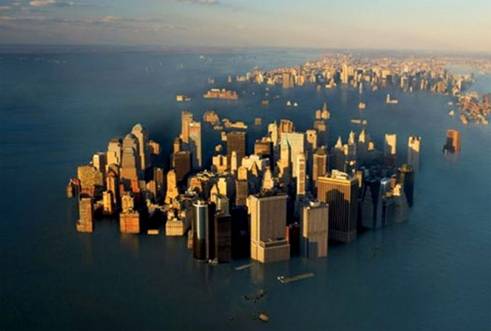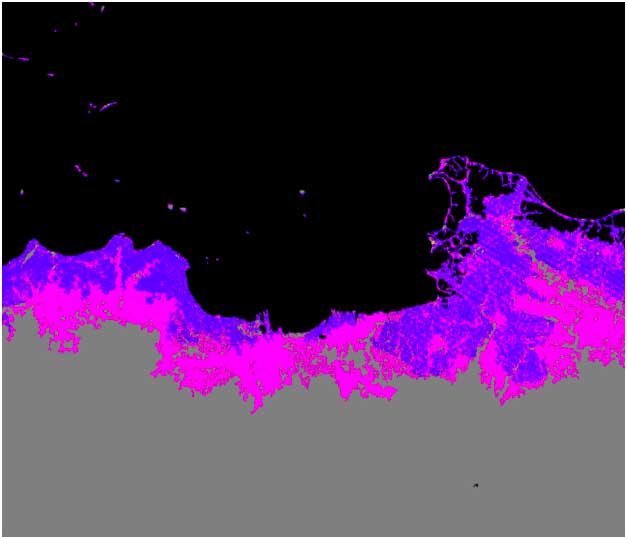
Major cities of the world are at risk of being submerged under rising sea levels over the next 30 years. This could put hundreds of millions of people at risk – their homes and jobs lost. A new study finds this. New elevation data triple estimates of global vulnerability to sea-level rise and coastal flooding.
A new digital elevation model known as CoastalDEM indicates that as many as 630 million people around the world live on land that lies below projected annual flood levels for 2100.
The study findings, published in the journal Nature Communications (Kulp, S.A., Strauss, B.H. New Elevation Data Triple Estimates of Global Vulnerability to Sea-level Rise and Coastal Flooding, volume 10, article number: 4844, 2019) on October 29, 2019, show that some 340 million people will be living on land that falls below the levels of average annual coastal land by 2050 – up from the previous NASA estimate of 250 million.


People at risk of annual floods live in countries that include Bangladesh, Indonesia and Thailand. The population in these countries face the threat of being entirely submerged making the areas at risk of being uninhabitable.
London Shanghai Hong Kong
According to the study by Scott A. Kulp and Benjamin H. Strauss, cities vulnerable in Asian countries include Jakarta, Shanghai, Tianjin and Hong Kong while the Vietnamese capital Hanoi and the entire southern tip of the country could be flooded.

Nineteen other countries, including Brazil and the UK could also see land being lost beneath the waves. In the UK, London is predicted to be affected.
The study report said:
Most estimates of global mean sea-level rise this century fall below 2 m. Employing CoastalDEM, the study shows, 190 million (M) people currently occupy global land below projected high tide lines for 2100 under low carbon emissions, up from 110 M today, for a median increase of 80 M. Under high emissions, CoastalDEM indicates up to 630 M people live on land below projected annual flood levels for 2100, and up to 340 M for mid-century, versus roughly 250 M at present.
The scientists estimate one billion people now occupy land less than 10 m above current high tide lines, including 250 M below 1 m.
The study report said: “Recent work has suggested that, even in the US, sea-level rise this century may induce large-scale migration away from unprotected coastlines, redistributing population density across the country and putting great pressure on inland areas.”
The study report said:
“Driven by climate change, global mean sea level rose 11–16 cm in the twentieth century. Even with sharp, immediate cuts to carbon emissions, it could rise another 0.5 m this century. Under higher emissions scenarios, twenty-first century rise may approach or in the extremes exceed 2 m in the case of early-onset Antarctic ice sheet instability. Translating sea-level projections into potential exposure of population is critical for coastal planning and for assessing the benefits of climate mitigation, as well as the costs of failure to act.”
It said:
“Central estimates in the recent literature broadly agree that global mean sea level is likely to rise 20–30 cm by 2050. End-of-century projections diverge more, with typical central estimates ranging from 50–70 cm under representative concentration pathway (RCP) 4.5 and 70–100 cm under RCP 8.5, though more recent projections incorporating Antarctic ice sheet dynamics indicate that sea levels may rise 70–100 cm under RCP 4.5 and 100–180 cm under RCP 8.5, and could even exceed 2 m or more in far-tail scenarios. Via a structured elicitation of opinion, experts now estimate there is a 5 percent chance 21st century sea-level rise will exceed 2 m. Both sets of projections are conditional on global carbon emissions; RCPs 2.6 (low emissions), 4.5 (moderate emissions), and 8.5 (high emissions) are considered for this analysis. These models use 2000 as the baseline year (zero sea-level rise), which we treat as present-day with respect to sea level for relevant vulnerability estimates. The results we present here are based on median sea-level projections, along with 90% credible intervals when derived from K14, and 90% intervals from simulation frequency distributions when derived from K17.
“The majority of people living on implicated land are in developing countries across Asia, and chronic coastal flooding or permanent inundation threatens areas occupied by more than 10% of the current populations of nations including Bangladesh, Vietnam, and many Small Island Developing States (SIDS) by 2100.”
The results the study found include:
The number of people on land that may be exposed to coastal inundation — either by permanently falling below MHHW, or temporarily falling below the local annual flood height. Coastal defenses are not considered, but hydrologic connectivity to the ocean is otherwise enforced using connected components analysis. Future population growth and migration are also not considered; rather, we use 2010 (essentially current) population density data from Landscan to indicate threats relative to present development patterns.
For one moderate future scenario, sea levels projected by 2050 are high enough to threaten land currently home to a total of 150 (140–170) million people to a future permanently below the high tide line, or a marginal increase of 40 (30–60) million. Total and marginal exposure each rise by another 50 (20–90) million people by end of century. A total of 360 (310–420) million people are on land threatened by annual flood events in 2100, or an extra 110 (60–170) million beyond the contemporary baseline. This case reflects greenhouse gas emissions cuts roughly consistent with warming of 2 °C and assumes a mostly stable Antarctic.
In the case of Antarctic instability, a total of 300 (270–340) million people today live on land indicated as vulnerable to an annual flood event by mid-century, rising to as many as 480 (380–630) million by 2100. These values represent marginal increases of 50 (20–90) and 230 (130–380) million from the present, respectively. All 90% CIs given originate from uncertainty in sea-level projections.
More than 70% of the total number of people worldwide currently living on implicated land are in eight Asian countries: China, Bangladesh, India, Vietnam, Indonesia, Thailand, the Philippines, and Japan.
In several developing countries south of China, ECWL exposure may be an order of magnitude more serious than previously expected as based on SRTM. Bangladesh, India, and Vietnam come to rival China in the median number of people living on land implicated by 2100, totaling 21–30 million even under the low emissions scenario, compared to 9–19 M today, and with another 10–25 million on land threatened by annual storm surge. Bangladesh, India, Indonesia, and the Philippines see a 5-fold to 10-fold change in estimated current populations below the projected high tide.
In Asia, even with deep cuts to carbon emissions, Bangladesh, Vietnam, and Thailand may, by end-of-century, face high tide lines higher than land now home to 19 (15–25)%, 26 (23–31)%, and 17 (15–18)% of their people, respectively, before accounting for episodic flooding events.
Continued high emissions with Antarctic instability could entail land currently home to roughly one-third of Bangladesh’s and Vietnam’s populations permanently falling below the high tide line. It follows that some coastal municipalities within these nations will see even larger proportions of their populations threatened with displacement.
Except for Djibouti, Guyana, and the United Arab Emirates, all of these are island nations, and thirteen are classified by the UN as Small Island Developing States (SIDS).
The study report said:
Results should therefore not be taken as projected impacts. Rather, they reflect the portion of presently developed land at risk in the future, which we interpret as a threat indicator. In addition, behavioral and economic responses to rising seas are likely to be unpredictable, due to the largely unprecedented nature and scale of the problem.
Furthermore, this analysis assumes a static coastal topography, with the exception of a linear model of vertical land motion implicit in the sea-level projections used. Erosion, wetland migration/accretion, and other morphological processes are not considered. It is difficult to predict how these factors affect the uncertainty of our results, especially since sea-level change may trigger complex process responses. However, we note that armored, developed, and maintained shorelines in urban areas, where vulnerable populations are concentrated, may generally be less susceptible to such factors than undeveloped land.
This study focuses on estimating populations occupying land below future high tide lines or annual flood levels, but results also indicate that some 110 M people live below MHHW today (with many more below annual flood lines).
Globally at present, levees and seawalls protect low-lying populations in many major deltas, such as around Shanghai, the Netherlands and New Orleans, and in areas experiencing rapid subsidence, such as parts of Jakarta and Tokyo.
Fourth and finally, many people today do live in unprotected areas subject to frequent coastal flooding (if not below the high tide line), such as in Bangladesh, or in boats or structures on or above the water (such as homes on stilts). These possibilities are likely to be most common in developing countries, and to be poorly documented.
The levees, seawalls and other defenses and accommodations currently protecting tens or hundreds of millions of coastal-area residents globally point to the potential for protecting ever-larger areas as seas rise. At the same time, current coastal defenses should not be assumed adequate to protect against future sea levels and storms without continued maintenance and, likely, enhancement. These countervailing possibilities point to the merits of reporting results based both on total ECWL exposure and on marginal increases in exposure from the contemporary baseline. Total exposure recognizes the potential vulnerability of all populations on low-lying coastal lands as sea levels rise. Marginal exposure highlights new populations of concern, while leaving out populations in areas that may be defended at present, and thus may be more likely to be defended in the future.
Even in light of the limitations identified, this research, using a significantly improved model of coastal elevations, provides new best estimates of the vulnerability of populated low-lying areas to rising oceans at global and national scales. Reliability increases with the size of the area evaluated, and with the water level considered; thus, global assessments for end-of-century sea levels and floods, under high sea-level scenarios, should be considered most robust. Analysis reveals a developed global coastline three times more exposed to extreme coastal water levels than previously thought. Even with low carbon emissions and stable Antarctic ice sheets, leading to optimistically low future sea levels, we find that the global impacts of sea-level rise and coastal flooding this century will likely be far greater than indicated by the most pessimistic past analyses relying on SRTM. These results point to great need for the development and public release of improved terrain elevation datasets for coastal areas, for example via the high-resolution imagery and lidar point clouds increasingly collected by satellite today. There is also great need for improved population data; data on the location, height and condition of coastal-area levees and seawalls; and improved global sea level and tidal models.
If our findings stand, coastal communities worldwide must prepare themselves for much more difficult futures than may be currently anticipated. Recent work has suggested that, even in the US, sea-level rise this century may induce large-scale migration away from unprotected coastlines, redistributing population density across the country and putting great pressure on inland areas60. It is difficult to extrapolate such projections and their impacts to more resource-constrained developing nations, though historically, large-scale migration events have posed serious challenges to political stability, driving conflict. Further research on global-scale modeling of the timing, locations, and intensity of migratory responses to increased coastal flooding is urgently needed to minimize the potential human harm caused by such threats.
SIGN UP FOR COUNTERCURRENTS DAILY NEWS LETTER










































